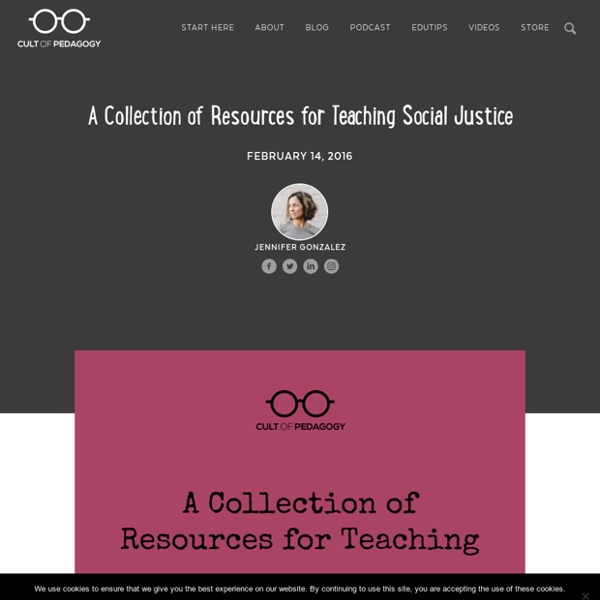



https://www.cultofpedagogy.com/social-justice-resources/
Related: Social Justice • What are the physiological effects of social injustice and inequity?-An interdisciplinary study[Infographic] Income Inequality in the United States in 2019 The infographic shown above explores the rise in income inequality in the United States. There is a particular emphasis on the rise over the last four decades, which have seen income inequality rise and rise. The whole topic is now very much a part of regular public discussion.
mchssocialstudies [licensed for non-commercial use only] / MCHS Social Studies - Summer 2017 The resources included in this workspace have been gathered from professional work at the secondary and college level as well as the GaDOE. The space is editable and intended for use by your department as you see fit. Use the SIDEBAR to navigate among pages on the site --> Understand changes in the standards Scientific Literacy: More Than Just “Reading” If someone gave a dense scientific journal article on polymer chemistry to Kathryn Sutherland, the world-leading expert on Jane Austen, she would be completely lost. Does this mean that Dr. Sutherland is not literate? On the contrary, she is the Professor of Bibliography and Textual Criticism as well as a Professorial Fellow at St. Anne’s College at the University of Oxford (Sutherland, 2016). Her job title and position lead me to believe that she is an exceptionally well-educated professor, and certainly highly literate.
view.email.kqed In every classroom, teachers try to engage students who have a variety of temperaments: extroverts, introverts and ambiverts. They work with children who crave sensory stimulation and with those who are highly sensitive to noise and visual distraction. While one temperament is not better than any other, introverted students are often “overlooked, undervalued and overstimulated in our schools,” said Heidi Kasevich, a 20-year teaching veteran and director of education for Quiet Revolution, an outgrowth of Susan Cain’s best-selling book on the power of introverts.
Disciplinary Literacy in the Science Classroom - Knowledge Resource Bank Disciplinary Literacy in the Science Classroom How disciplinary literacy instruction can help your students Students were shown to spend significantly more time on important literacy activities that supported science inquiry, e.g. student discussion and writing. The PRO (Premise-Reasoning-Outcome) strategy was used to support three aspects of science learning: ◦ learning the specific content of the topic ◦ phrasing answers for written examination questions ◦ structuring the reasoning process Students who used the PRO structure in writing explanations for questions which asked for a scientific explanation: ◦ scored significantly higher grades for the questions ◦ reported that the PRO strategy provided them with a useful organisational structure for writing scientific explanations
Practical Tools for Teaching News Literacy The Center for News Literacy has partnered with Intermediate School 303, a public middle school in New York City, to help the school implement a cross-curricular news literacy program. As a follow-up to our post offering 50 ways to teach with current events, we asked Rory O’Connor, director of the Digital Resource Center at Stony Brook University’s Center for News Literacy, to share practical ways to help students become savvy news consumers. — The Learning Network The Need for News Literacy Instead of a limited number of “trusted” and “objective” news sources, like the familiar network anchors, we now have an almost limitless number of outlets on the Internet and TV. In fact, anyone can publish a blog or tweet. Kicking It Up a Notch: Becoming a Culturally Relevant Science Educator - the Node I want to talk about how you can take your science teaching to the next level, where young people, and especially underrepresented young people (people of color, LGBT, immigrants, girls, etc.), find what you’re teaching engaging, relevant to their lives, and which research shows that if done thoughtfully, enables them to achieve a higher level of learning. I’m not suggesting you change your science content. Instead, I’d like to illustrate the importance of modifying your teaching to be culturally relevant. Ideally you are already providing hands-on, inquiry-based science experiments, which are known to increase achievement and engagement. [Shameless plug: This is something that a zebrafish program that I work with, BioEYES, does well, so if you need help see our website (www.bioeyes.org), our latest research paper in PLOS Biology that details our results and how to launch an outreach program in your area, read our Node post from 2010, or contact me directly.] References
Social Studies Web Sites for Teachers Go Back: Virtual Middle School Library Home / Resources for Teachers and Parents Menu / Social Studies Social Studies Menu: General Sites | Current Events | Geography | Government | History - General | History - United States | History - Pennsylvania | History - World General Sites